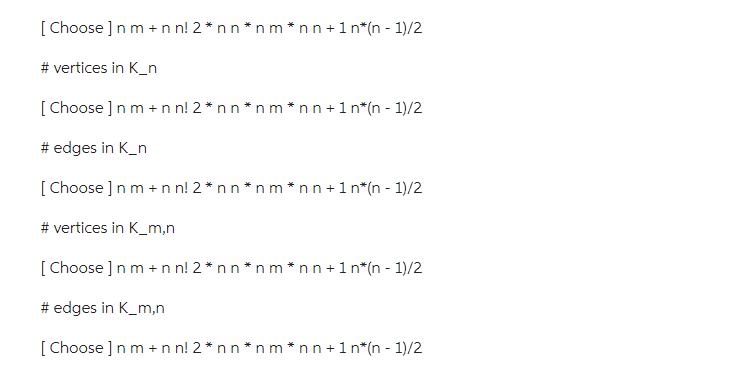Answered step by step
Verified Expert Solution
Question
1 Approved Answer
A cycle Cn, n 3, consists of n vertices, V, V2, ...,Vn and edges (v, v2), (v2, v3),... (Vn-1, Vn), and {vn v1). A


A cycle Cn, n 3, consists of n vertices, V, V2, ...,Vn and edges (v, v2), (v2, v3),... (Vn-1, Vn), and {vn v1). A complete graph on n vertices, denoted by Kn, is a simple graph that contains exactly one edge between each pair of distinct vertices. A complete bipartite graph Km,n is a graph that has its vertex set partitioned into two subsets of m and n vertices, respectively, with an edge between two vertices if and only if one vertex is in the first subset and the other vertex is in the second subset. How many vertices and edges do each of these graphs have? Answers may be used more than once. Note: in what appears below, Cnis denoted as C_n Knis denoted as K_n Km,nis denoted as K_m,n multiplication is denoted using an asterisk (*) Group of answer choices # vertices in C_n [Choose ] n m + n n! 2*nn*nm*nn +1n*(n-1)/2 # edges in C_n [Choose ] n m + nn! 2*nn*nm*nn +1n*(n-1)/2 # vertices in K_n [Choose ] n m + nn! 2*nn*nm*nn +1n*(n-1)/2 # edges in K_n [Choose ] n m + nn! 2*nn*nm*nn +1n*(n-1)/2 # vertices in K_m,n [Choose ] n m + nn! 2*nn*nm*nn +1n*(n-1)/2 # edges in K_m,n [Choose ] n m + nn! 2*nn*nm*nn+1n*(n-1)/2
Step by Step Solution
There are 3 Steps involved in it
Step: 1
The detailed ...
Get Instant Access to Expert-Tailored Solutions
See step-by-step solutions with expert insights and AI powered tools for academic success
Step: 2

Step: 3

Ace Your Homework with AI
Get the answers you need in no time with our AI-driven, step-by-step assistance
Get Started


